I don't talk about the RCAF a lot here, not due to any lack of interest but because there simply isn’t a lot for someone like me to talk about that deserves a full discussion.
This isn't a bad thing. The RCAF has managed to get through most of their major projects and have entered the phase of awaiting delivery. Over two hundred new aircraft will join the RCAF fleet in the next decade.
From F-35 to P-8, MQ-9 to a host of trainer aircraft, the RCAF is essentially being torn down and rebuilt in its entirety. What comes out of this will be a new force, ready to tackle the challenges of the 21st century. Very little will remain of the current fleet once all is done.
Yet not every project in the RCAF lineup is looking at a replacement, is it? For some, there is not a desire to expand on what exists but to add to what we can do. That is where the Airborne Early Warning and Control project comes in.
Adding new capabilities
I will be the first to admit that I was surprised when the AEWC project was announced in Our North Strong & Free. While I knew it was a major want, I didn’t expect the government at the time to go for it with so many other things on the docket.
This is inevitable with such policies. Certain things will inevitably be told they have to wait, and funding can only go as far as it exists. It was one of those major, multi-billion dollar projects like the Continental Defence Corvette that I expected to be pushed to the backburner.
So imagine my surprise when it was not only included but with actual funding attached! The want for an AEWC aircraft has been years in the making, with numerous concepts floating the 'trifecta' of a new Maritime Patrol aircraft (CP-8A), an unmanned system (CQ-9B), and an AEW aircraft.
While the Canadian Multi-Mission Aircraft and Remotely Piloted Aircraft System projects both trudged through years of procurement, with RPAS being a decades-long affair if we count JUSTAS, the missing layer of AEW never materialized until this point.
That doesn't mean that Canada hasn't been down the road before. We've had an on and off relationship with the NATO AWACS program, having been a member, left in 2011 under the guise of saving a few dollars (technically I believe we fully withdrew in 2014), and then rejoined back in 2018, to which we've recently brought that contingent to full strength in the last two or so years.
We've also had a contingent working with USAF AEWC aircraft since the 1980s. That relationship has continued, and likely will into the foreseeable future. This is what we have relied upon for AEWC up until this point.
However, as the USAF E-3 fleet ages, the availability of these platforms to be up north and to take on tasks becomes more and more scarce. We don't know what the future of AEWC looks like from an American perspective either.
As of this writing, the U.S. E-7 purchase is up in the air. The new idea floating around is to use the E-2D platform as an interim solution while a space-based sensor network is developed to take over that capability.
However, we don't know yet exactly what this looks like or what this means. It makes it hard for us to remain reliant on the United States for this critical capability when we don't even know whether they will be in the AEWC game in the future, or if it will be a viable option for us.
So the choice to pull the trigger on acquiring this capability seems appropriate given these factors, and make no mistake, this is a very important capability to have.
AEWC is a vital asset in the layered sensor network. It is a vital part of the deterrence chain, being able not only to detect and track but also target and assist in the engagement of adversaries. This is especially true when you are looking at a country as vast as Canada.
Our size has always been a natural hassle to our security. No matter how many fighter aircraft we have, how many P-8, how well our OTH-R function, there will always be a hard press to cover every inch effectively.
That is where AEWC aircraft come in so well to the chain, bridging that gap between, for example, the capabilities of the F-35 and the limits that our OTH-R have in tracking aerial threats.
To use a broad comparison, an AEWC aircraft is a lamp to a fighter jet's flashlight. While a flashlight can illuminate where it's able to be directed, a lamp can light up the whole area. In this case many AEWC aircraft, though not all, provide omnidirectional coverage of the battlespace. AEWC aircraft can also direct more power into their sensors thanks to their larger size and energy capabilities, allowing them to push their sensors out farther than fighter aircraft.
Of course AEWC aircraft are more than just extra-large radar platforms. They are multi-purpose aircraft, able to be used not just in an aerial capacity but also in ground and maritime surveillance. They are C4ISR platforms, ELINT platforms. Some go a step farther and integrate even more sensors and capabilities to form true Multi-Mission Aircraft, including for tasks such as dedicated Maritime Patrol or SIGINT.
They are able to command the airspace while also extending our ability to both see and engage targets in the vastness of the North. They will work in tandem with our fleet of F-35 not just to relay information and provide broader coverage but also to assist them in engaging targets beyond the ranges of the F-35's radar systems.
They will provide a vital node to the wider network that, slowly, we have been building, helping to process and transmit large amounts of data coming in from dozens of different nodes at the same time as providing their own coverage.
They are the head chef, keeping track of orders, directing the kitchen, and sending out the dishes. They are the brains and spine of the aerial battlespace.
For a country like Canada how could this not be vital? Of all the countries up there, few benefit from these advantages as much as we do, and while we have been fine to allow this capability to be maintained by our allies for us, increasing demand and deviating philosophies have put us in a position where we can't afford to not have that sovereign capability.
Yet AEWC aircraft are a broad category. They can include everything from the larger AEWC aircraft many are familiar with to things like Unmanned Aerial Systems, rotary aircraft, and even blimps, if you can believe it.
So, what are we actually looking for?
As of this writing, the AEWC project is still in the analysis phase. We don't have a straight set of requirements available to really set anything definitive. Of course, we do have word of mouth, and some rumors running around, about what exactly we're thinking of.
Of course, as always, take this with some salt. Requirements change, things get refined, and sacrifices are sometimes made. We are still early in this process which means inevitably some things will be different from the end result.
As of right now, the project aims to acquire 6-8 fixed-wing aircraft. These aircraft will need to be capable of conducting both Aerial and Maritime surveillance and detecting both Aerial and Surface targets. They will need to be able to integrate seamlessly into the network. They will likely also need to be capable of Air-to-Air refueling (AAR).
That is one requirement that really seems to get to people. It certainly provides a head-scratcher to many. Let me break it down a bit. The issue that these aircraft will face is that, usually, they will be operating in the Arctic.
An AEWC aircraft is only as useful as long as it's in the air. Once it is on the ground you lose that ability. When discussing the Arctic, even Forward Operating Locations have a civil component to their duties.
Not only do you not want these aircraft to even land, you also need to deal with the fact that there is limited fuel capacity up there and not only are you sharing it with your fellow RCAF aircraft but oftentimes the local communities also rely on this same fuel supply.
Similarly, ensuring that the supply is there, and not, say, contaminated at these locations is another task. All of which can be avoided if you have an aircraft able to be supported by a tanker. This allows it to stay on station without having to waste time and effort on landing, refueling, and getting back up.
You want these aircraft up there as long as humanly possible. You want a persistent capability, not one that has to be cycled in and out of the battlespace. For that reason, AAR is likely to become a High-Level requirement.
The current timeline will see delivery sometime in the mid-2030s. Contract award would be ~2030/2031 so make no mistake, this project is a ways off from delivery and you can likely sit still on news.
So now that we know, who actually fits the bill?
As of now, we can't say for certain who will end up fitting the requirements, as always with these things. We do however have a rather interesting scenario. As you imagine, these kinds of systems are very specialized.
For many years it wasn't even common for many countries to have this capability on hand, and while that has changed, there is still only a very small handful of options available on the market and the majority have already jumped on to the project.
I had the chance to see these options at CANSEC, and two of the three options happen to use the same airframe! Let's break them down:
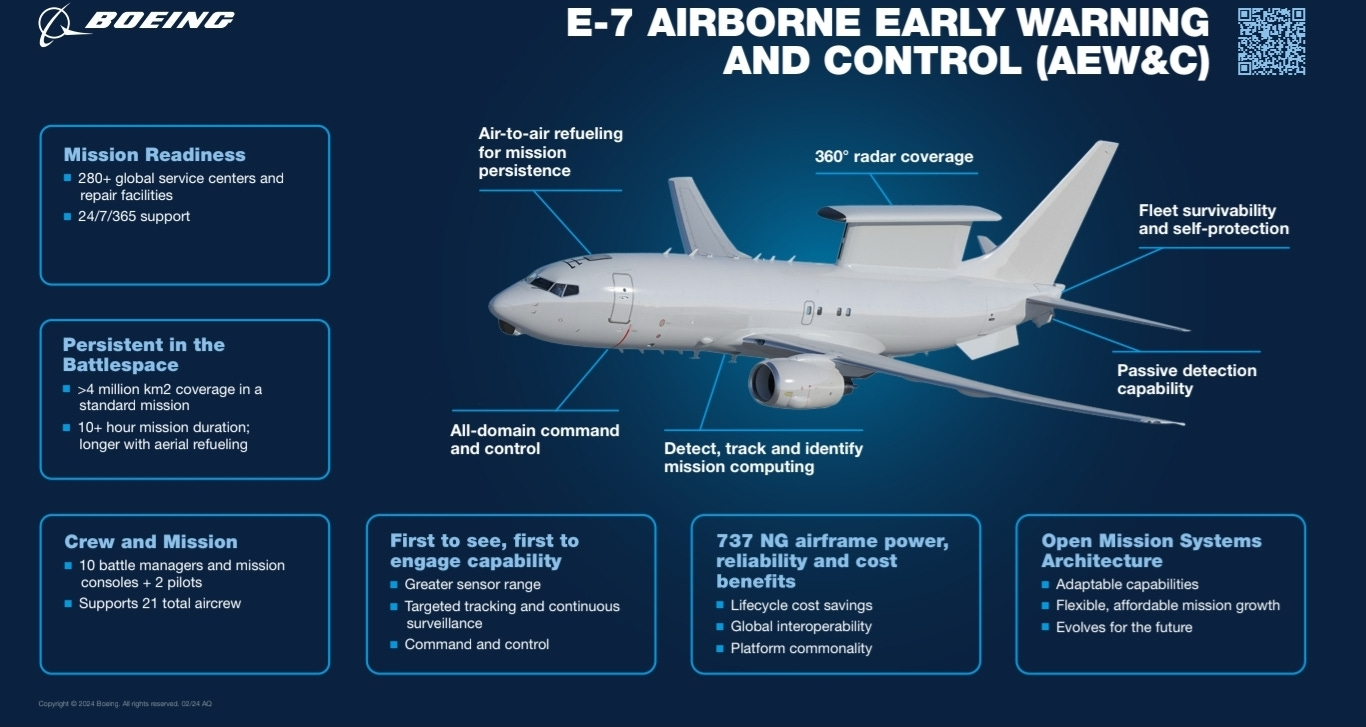
E-7 Wedgetail
By far the most discussed, and the leading candidate in discussions is the E-7 Wedgetail. At a glance it feels almost too easy of a pick but first let's look at the aircraft itself.
The E-7 is built on the Boeing 737-700 airframe, fitted with Northrop Grumman’s Multi-role Electronically Scanned Array (MESA) radar mounted in a dorsal fin above the fuselage. The MESA radar is able to track targets out past 500 miles away, significantly farther than the range of the F-35’s AN/APG-81.
The E-7 has a service ceiling up around 41,000 ft and a range of 4000+ miles. It also has an on-station endurance north of 15 hours with AAR. It can track over 180 targets at once and guide strike packages, fighters, or interceptors in real time, while also coordinating air-to-air refueling or joint fires.
The E-7 was originally developed to fulfill the needs of the Royal Australian Air Force in the mid-2000s. Since then the aircraft has been exported to the United Kingdom, Turkey, South Korea, and NATO. As I mentioned before, U.S. plans are still on the table.
There is no one that I know who denies that the E-7 is the premier choice. It is widely in service with allies, including NATO, and is widely considered the best system available to us, eclipsing the capabilities of the competition, primarily due to the power and size advantage that the 737-700 provides. It also shares commonality with the 737-based P-8.
However, as many know, American systems are... less than liked right now. While the aircraft was not designed for the USAF it is, at its core, American. To many that is enough to throw it from consideration.
I am not one of those people. Many of you already know that. I will not toss options because they are American, especially if they are undoubtedly the best option, at least from a technical standpoint. This isn't an endorsement, merely refusal to toss out the E-7 when it fits so well.
And while the Usually. pushing out the E7 does effect its viability, and does unfortunately greatly effect it's future development, it still has a fairly active user base, and most of all is a common NATO platform, which we are still going to remain a part of.
It just makes too much sense for me to not consider it, even if the U.S. abandons the platform.
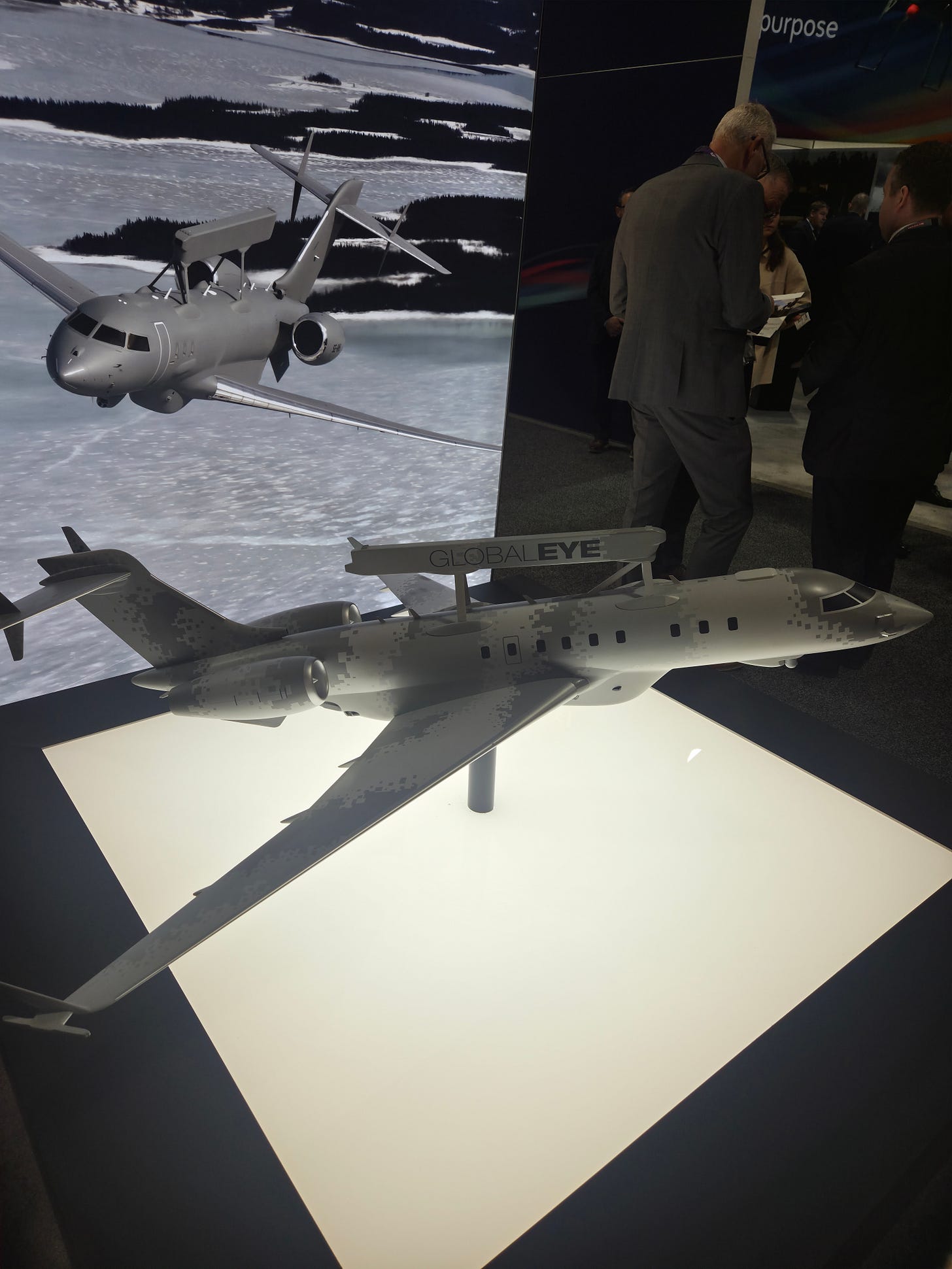
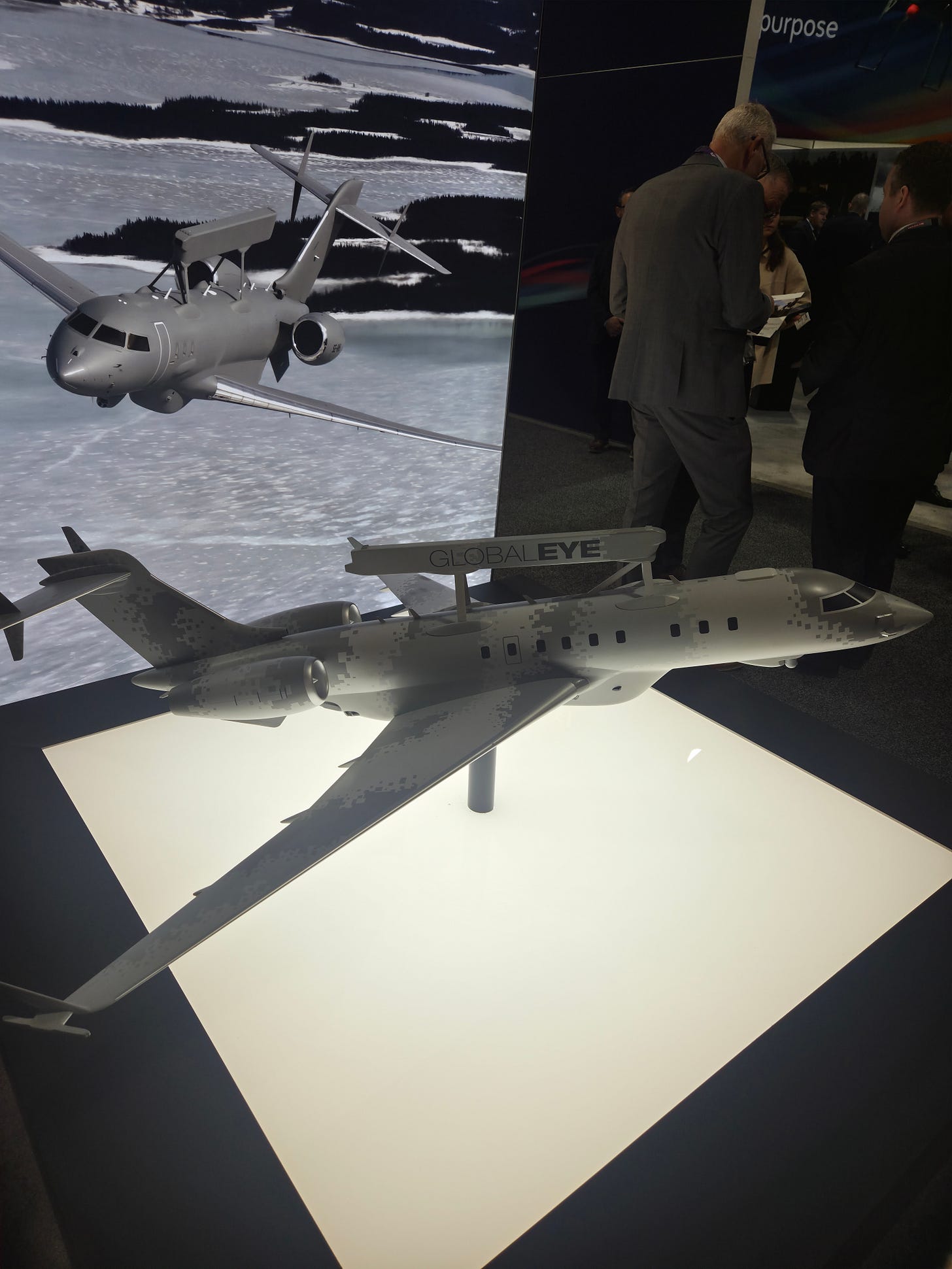
Saab GlobalEye
The second option often discussed is the Saab GlobalEye, based off the Canadian-built Bombardier Global-6000 series. It is one of two Bombardier options here and is by far the most popular alternative.
In fact, for the most part, you would think that this and the E-7 were the only options to exist. Conversations around AEWC often revolve exclusively on the never-ending back and forth that exists between these two aircraft.
GlobalEye is a true Multi-Mission Aircraft, if you want it to be. Its centerpiece is the Erieye ER radar—a long-range, side-looking, active electronically scanned array (AESA) mounted in a dorsal “plank” fairing—that provides 240° coverage per side out to more than 550 km and can simultaneously handle air, sea, and ground targets.
This can be paired with a 360° Leonardo Seaspray maritime surveillance radar, dedicated ELINT/SIGINT suites, and an EO/IR turret. When I said she was Multi-Mission, I meant it.
The GlobalEye has a mission endurance of over 11 hours and a ceiling above 40,000 feet. It has a range of ~6000 miles with the smaller size of the Global 6000-series chassis, according to Bombardier being the perfect size to be able to operate in Canada’s more underdeveloped and smaller Northern Airstrips.
The Erieye radar of the GlobalEye has seen a fair amount of success on the export market, primarily outside the western sphere. While Sweden has been the main operator of the system, others such as Mexico, Pakistan, the UAE, Saudi Arabia, Brazil, Poland, and now even Ukraine have all found use of the Erieye radar.
There is no denying that it has been a fairly popular alternative, and the very nice people of Saab love to bring it up. I had a lot of pleasure in talking to the company about GlobalEye at CANSEC and I walked away feeling very nice about their answers.
They were very quick to not just speak about the aircraft’s advantages, the Canadian Supply Chain, the domestic airframe, their willingness to transfer IP but also to its limits.
I always respect when companies can admit their weaknesses and limits. It speaks a lot to me when people are willing to be open about where their products are. Saab made no attempt to deflect when I asked about the comparisons to the E-7.
They were very open to the fact that Erieye was not at the level of MESA. They admit it fully. MESA is a larger, more powerful system and what they proposed wasn't meant to watch it 1:1.
What Erieye was, to them, was something that still did as expected, on a Canadian aircraft, designed to be a true Multi-Mission Aircraft. They were very open to the concern that, at its base, GlobalEye does not have 360⁰ coverage, and had a solution that would fix that.
They were also open that they would see on AAR and would work on that. Do I believe them? Eh. I never like to trust 'working on' solutions to products. I can say I'm working on a solution to anything, and the proposed aircraft that was shown to me was not that but the base GlobalEye, but I give credit for them admitting to these issues.
What GlobalEye aims to be is a cheaper, Canadian-based solution. It is trying very hard to sell the Global airframe as the preferred option over the 737 for deployment in the Arctic.
It is not as powerful as the E-7, and there are serious issues it needs to rectify in order to meet some potential high-level requirements.
There is also questionability, with AAR, whether that Arctic advantage will pan out as much as they hope it will. Will they be deploying off any airfield where the E-7 could not operate? The advantage of size is something that exists, but only if one plans to exploit the advantage.
Despite all that, I was very happy with the Saab team and plan to keep in touch with them as things develop. Hopefully next time we meet we will be able to address some of these issues with something concrete to show to me, plenty of time.
Yet there is still one more, often underdiscussed platform, one that outside the RCAF circle many are unlikely to have heard of
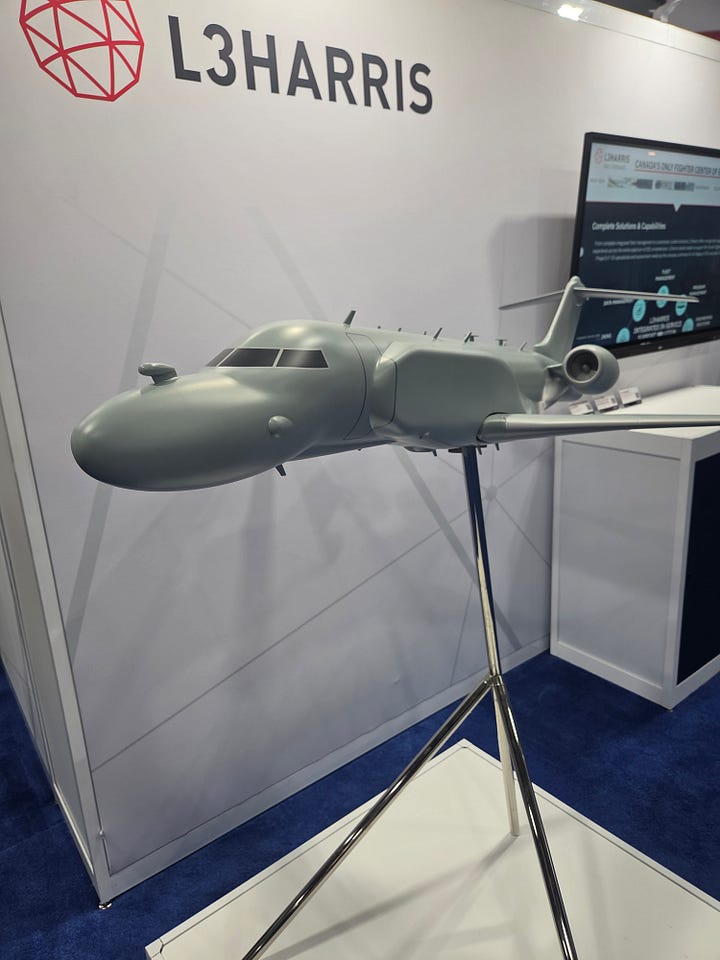
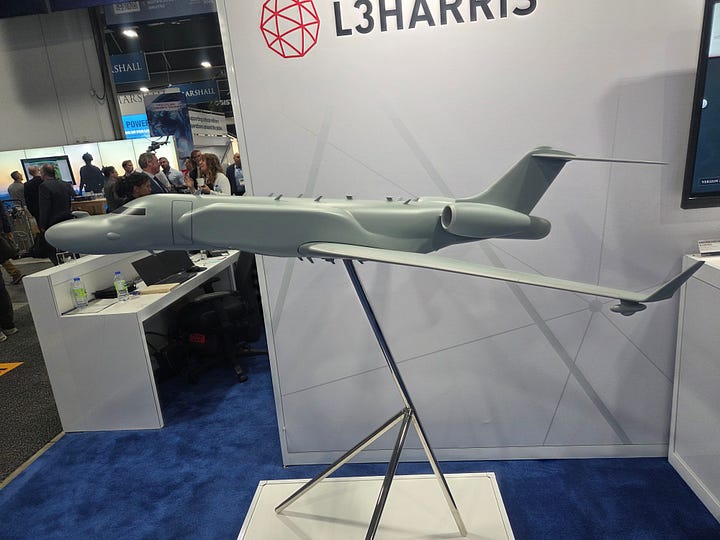
L3 Harris/IAI CAEW
Amidst the back and forth between GlobalEye and the E-7 there has been a fairly active discussion among those more involved around one particular platform.
The CAEW is not a platform that is often discussed. It is not a platform that many, I think, even know exists. Perhaps some have heard of the Gulfstream variants in service with the likes of Israel, Singapore, and Israel.
This though is different. Instead of a Gulfstream, L3/IAI plan to provide a variant based off of the Global 6000-series, just like GlobalEye, and they were in full force at CANSEC this year to show her off.
The L3Harris/IAI-ELTA Conformal AEW&C (CAEW) is built around the Bombardier Global 6000/6500 airframe.
At its base is ELTA’s EL/W-2085 AESA radar, which uses a conformal side-array layout—flush-mounted panels along the fuselage—for continuous 360° coverage without the drag penalty of a dorsal radar. The 2085 radar can detect and track airborne and surface threats at ranges past 500 km.
The CAEW is also fitted with a dedicated SIGINT and ELINT system, though skips on adding things like a dedicated Maritime Surveillance capability like GlobalEye.
Because of its use of the same airframe the CAEW shares many similar capabilities to the GlobalEye.
They share the same ceiling, range and endurance capabilities. Yet L3 has made sure to jump on the issues the RCAF would have with the platform. Unlike the GlobalEye, L3 is offering a system that comes with a proven, omnidirectional capability.
L3 has also been working with Bombardier, as part of a similar Korean competition, to integrate an AAR capability to the platform. They even went as far as to show this off at CANSEC!
You can actually say that the campaigns between SAAB and L3/IAI are very similar, both offering what they see as a Canadian aircraft, and both offering IP transfers along with any potential deal.
What L3 highlights on top is its extensive Canadian operations, and its active role in supporting many RCAF aircraft already through the Fighter Aircraft Depot, giving them an ISS network able to better support the CAEW if selected for AEWC.
I was highly impressed with what I saw from L3 at CANSEC. They not only provided a very nice solution but a plan on how to support these aircraft, and the credentials to back it up.
They've seen the issues ahead of time and worked hard to make sure that once the competition was launched they would have a proper solution in hand to show off. I walked away very happy with this solution, although sadly they would not entertain discussing competitors.
Thoughts
Obviously there is some big conditions to all of this. First off, the current Liberal government has committed to buying a Canadian solution. That would effectively eliminate the E7.
However I don't trust they will stick to that. Call me a cynic, but if things come forth as they are, I don't think the government would make a huge fight over this.
There is also the truth. The E7 is the best option from a technical standpoint. No one argues this, not even those competing against the E7. Its a question of power. Simple as.
However, and you might be surprised to hear this from me. I actually am not against a Global-based aircraft. Far from it. I am supportive of one so long as it meets our needs.
Although HONESTLY my idea of a Global-based AEW is also based on my own desire to see us adapt the Global platform for several different tasks as a common, Canadian platform.
I truly believe there is a lot of potential value in using the Global-series for further development, such as for HADES or Pegasus like surveillance aircraft, something like the EC-37B for electronic warfare, or even something like the E-11.
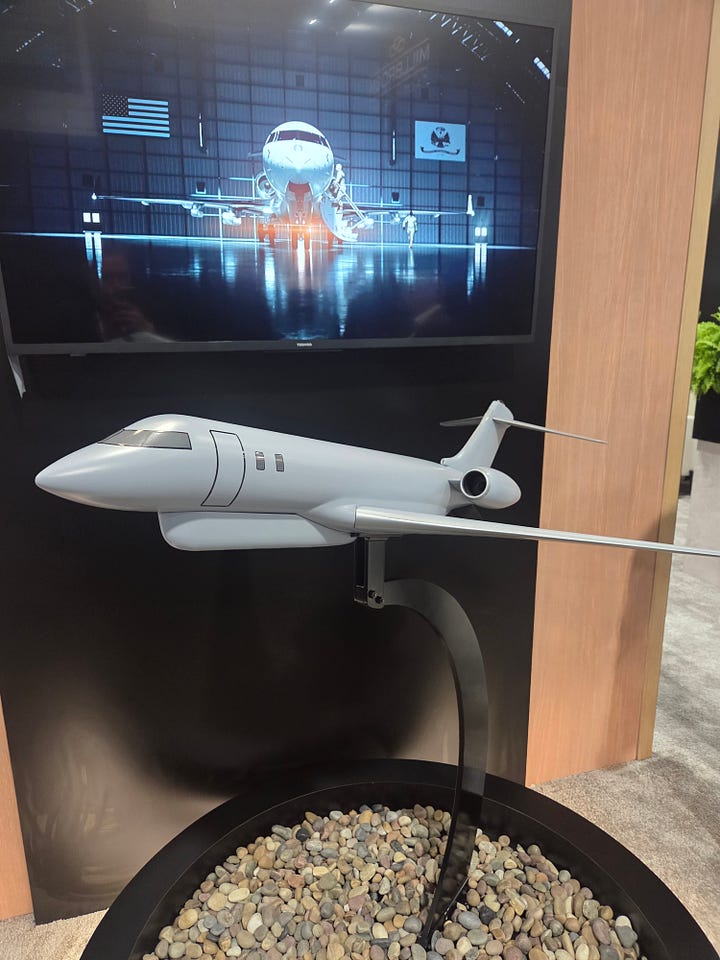
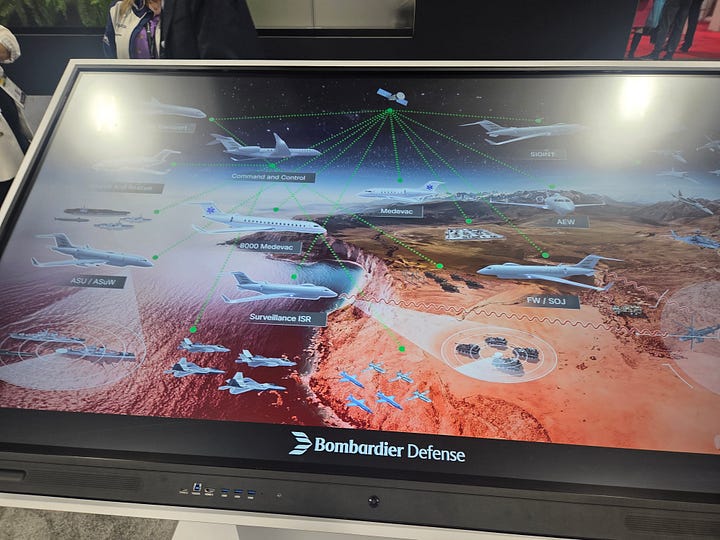
The Global has shown to be a valuable aircraft in that role, being able to be modified for a number of different roles, roles that we have notable lacks in. Something like HADES can bridge the cap between something like the Guardian and P8, while being far more capable than platforms like Vigilance are.
Having it share the same airframe as a potential AEW, both made in Canada, is an exceptional advantage in my mind, and the future growth advantage is something that I believe has value.
Secondly, we dont know who else might come into this. Remember that we are still a few years away from an RFP. That gives some time, and while I don't expect many, there are a few companies, such as Raytheon that are actively developing solutions.
We can't discount that some of these might come up, and potentially provide good options. However I am assuming these three, no matter what, will be the top three options unless something truly game-changing comes up.
At this time I won't endorse an individual platform, but I will give support for a Global-based solution. Even if there is some sacrifice over the E-7 in terms of capability, I believe it will still be enough to do what we need.
There is always some sacrifice to be made, and so long as it can meet the HLMR I believe that it would be the proper solution, both to support Canadian industry and open the doorways to new aircraft in the future.
I will say, I was very happy with L3. I think they raised some great points, and they have experience working with Global platforms enough for me to give them some trust on this file.
However, we are still a long way away, far to long for me to endorse anyone at this time. So don't think to hard about it at this time. We can judge more once things become more clear.


I agree with you Noah and favor the Global proponent for all the reasons you stated!
This acquisition provides an organic, high-latitude AEW layer that fills the low-altitude cruise-missile ISR gap or pop-up threats that ground OTHR and SPY-7 cannot see and would feed tracks into NORAD SHIELD’s cloud C2. I love the multi-domain potential capability of Globaleye - air, sea and land C2/ISR. The platforms limitations vs. E7 could be mitigated with LEOsat upgrades (which we need to do anyways) - providing theatre wide eyes and C2. I assume this architecture is being planned with the RCAF's 3 Canadian Space Division...